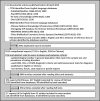Prevalence of eating disorders in the general population: a systematic review
- PMID: 24991159
- PMCID: PMC4054558
- DOI: 10.3969/j.issn.1002-0829.2013.04.003
Prevalence of eating disorders in the general population: a systematic review
Abstract
Background: The estimated prevalence of eating disorders reported in community surveys from different parts of the world varies widely but there has been no systematic attempt to identify the reasons for these differences.
Objective: Use meta-analysis methods to pool data from community surveys about the prevalence of eating disorders in different locations and to identify the factors that are associated with the reported prevalence of eating disorders.
Methods: Based on pre-defined inclusion and exclusion criteria, studies were identified from the following databases: PubMed/Medline, PsycINFO, ISI web of knowledge, Ovid, Chinese National Knowledge Infrastructure, Chongqing VIP database for Chinese Technical Periodicals, WANFANG DATA, and Chinese Biological Literature Service System. Statistical analysis was conducted using R software.
Results: Among the 9315 unduplicated reports reviewed (one-fourth of which were published in Chinese) only 15 - with a pooled sample size of 72,961 individuals - met the inclusion criteria for the analysis. None of the included studies were from China and only one Asian country (South Korea) was included in the analysis. The estimated lifetime prevalence, 12-month prevalence, and 4-week prevalence of any eating disorder was 1.01% (95% confidence interval [CI], 0.54-1.89), 0.37% (CI, 0.22-0.63), and 0.21% (CI, 0.15-0.28), respectively. Estimated lifetime prevalence of anorexia nervosa, bulimia nervosa, and binge eating disorder was 0.21% (CI, 0.11-0.38), 0.81% (CI, 0.59-1.09), and 2.22% (CI, 1.78-2.76), respectively. The estimated female-male ratio for lifetime prevalence of any eating disorder was 4.2. The lifetime prevalence of any eating disorder reported from studies conducted in Western countries was 6.1-fold greater than that reported in a single study from South Korea. Over time there has been a non-significant increase in reported prevalence of any eating disorder and a significant increase in reported prevalence of anorexia nervosa.
Conclusions: Eating disorders are common in the general population, more common in women than men, and more common in Western countries than in Asian countries.The reported prevalence is increasing over time, but this may be due to changes in diagnostic criteria. There are serious limitations in the available epidemiological data, primarily differences in the conditions included among eating disorders and the lack of acceptable epidemiological studies from low- and middle-income countries (including China).
背景: 世界各地关于进食障碍的流行病学研究得到的患病率数据不尽一致,目前尚缺乏系统综述研究以明确这些差别的原因所在。
目的: 运用Meta分析的方法汇总不同地区普通人群进食障碍的患病率数据,以确定与患病率相关的因素。
方法: 系统检索PubMed/Medline、PsycINFO、ISI web of knowledge、Ovid、中国知识资源总库,中国科技期刊数据库,万方数据,中国生物医学文献服务系统的数据库,收集关于进食障碍患病率的文献,按照预先制定的纳入及排除标准筛选相关研究。采用R-2.15.2软件进行统计分析。
结果: 共检索到9315篇不重复的文献(约四分之一为中文文献),其中仅15项研究符合纳入标准,累计调查72 961人。纳入的15项中无国内研究,仅一项来自于亚洲国家(韩国)。估计的进食障碍的终生患病率为1.01%(95%CI,0.54~1.89%),12个月患病率为0.37%(95%CI,0.22~0.63%),4周患病率为0.21%(95%CI,0.15~0.28%)。神经性厌食、神经性贪食、暴食性障碍的终生患病率分别为0.21%(95%CI,0.11~0.38%)、0.81%(95%CI,0.59~1.09%)、2.22%(95%CI,1.78~2.76%)。女性进食障碍终生患病率与男性之比为4.2。欧洲国家进食障碍的终生患病率约为韩国研究报告数据的6.1倍。随着时间推移,总的进食障碍患病率有所升高,但无统计学意义,但神经性厌食症的患病率有统计学意义的升高。
结论: 普通人群中进食障碍较为常见,女性比男性多,西方国家比亚洲国家多。可能由于进食障碍的诊断标准有了变动,近年来报道的患病率有增高趋势。研究局限性包括可获得的流行病学资料非常有限,不同研究中进食障碍包括的类别有所不同以及缺少中低收入国家(包括中国)中合适的流行病学研究。
Conflict of interest statement
Figures
References
-
- Mond JM, Owen C, Hay P, Rodgers B, Beumont P. Assessing quality of life in eating disorder patients. Qual Life Res. 2005;14(1):171–178. - PubMed
-
- Wang LY, Nichols LP, Austin SB. The economic effect of Planet Health on preventing bulimia nervosa. Arch Pediatr Adolesc Med. 2011;165(8):756–762. - PubMed
-
- Padierna A, Martín J, Aguirre U, González N, Muñoz P, Quintana JM. Burden of caregiving amongst family caregivers of patients with eating disorders. Soc Psychiatry Psychiatr Epidemiol. 2013;48(1):151–161. - PubMed
-
- Johnson JG, Cohen P, Kasen S, Brook JS. Eating disorders during adolescence and the risk for physical and mental disorders during early adulthood. Arch Gen Psychiatry. 2002;59(6):545–552. - PubMed
-
- Swinbourne J, Hunt C, Abbott M, Russell J, St Clare T, Touyz S. The comorbidity between eating disorders and anxiety disorders: Prevalence in an eating disorder sample and anxiety disorder sample. Aust N Z J Psychiatry. 2012;46(2):118–131. - PubMed
LinkOut - more resources
Full Text Sources
Medical
Miscellaneous




